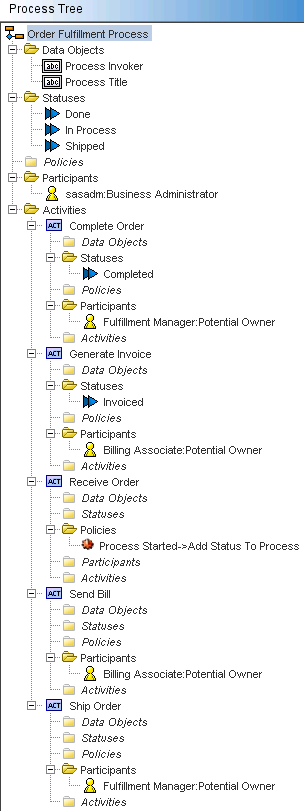Order Fulfillment Process
The Order Fulfillment
process template illustrates parallel flow control where two paths
are processed concurrently, and the converged path does not start
until both of the parallel activities finish. This workflow is initiated
when the system receives an order. Then, a billing associate generates
an invoice while a fulfillment manager completes the order. When both
of these tasks are completed, the fulfillment manager ships the order.
Finally, after the order has shipped, the billing associate sends
the bill.
Order Fulfillment Process Elements
|
Default data object
of type Short Text defined for all processes. Holds the user name
of the person who starts an instance of this process.1
|
||
|
Default data object
of type Short Text defined for all processes. Holds the title for
a process instance.1
|
||
|
Default status value
defined for all processes.2
|
||
|
Status value defined
for entire process.2
|
||
|
Status value defined
for entire process.2
|
||
|
This is a group type
participant assigned to the activity level of the process with the
workflow role of Potential Owner. Only users who are members of this
group can generate invoices and send bills. The group is an explicit
value, so it must exist in SAS metadata.
Because the workflow
role assigned is Potential Owner, any user from that group can claim
the task. Once it is claimed, the user becomes the Actual Owner, the
task is locked, and no others users can perform the activity.3
|
||
|
Status value defined
for Generate Invoice.4
|
||
|
This is a group type
participant assigned to the activity level of the process with the
workflow role of Potential Owner. Only users who are members of this
group can complete and ship orders. The group is an explicit value,
so it must exist in SAS metadata.
Because the workflow
role assigned is Potential Owner, any user from that group can claim
the task. Once it is claimed, the user becomes the Actual Owner, the
task is locked, and no others users can perform the activity.3
|
||
|
Status value defined
for Complete Order.4
|
||
| 1This data object value is defined at the root process level and is set as visible within the entire subtree by default. This setting allows access to the value by decisions and policies at run time by all contained activities and subprocesses. However, the value is not accessible as a local copy of the data object. | ||
| 2This status value is defined at the root process level and is set as visible within the entire subtree by default. This setting allows access to the value by decisions and policies at run time by all contained activities and subprocesses. However, the value is not accessible as a local copy of the status. | ||
| 3Only users can be assigned to the Actual Owner workflow role. Participants of SAS Metadata type group or role type must be assigned as Potential Owner and their user members must claim the task to become Actual Owner. | ||
| 4This status value is defined at the activity level and is set as visible within the entire subtree by default. This setting allows access to the value by decisions and policies at run time by all contained activities and subprocesses. However, the value is not accessible as a local copy of the status. | ||

